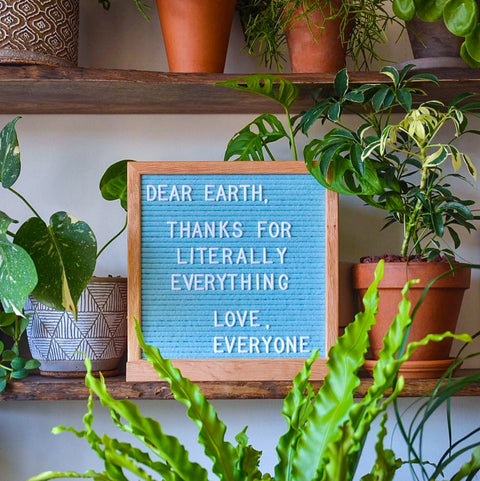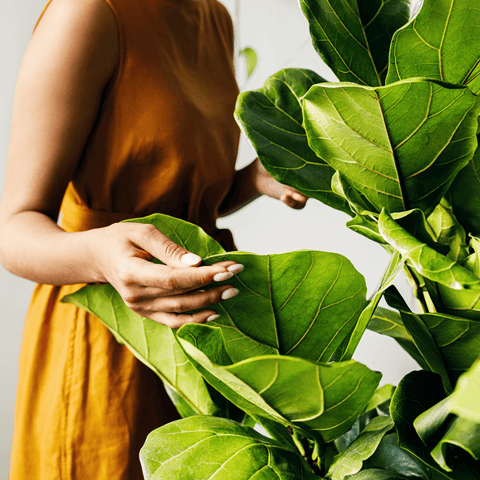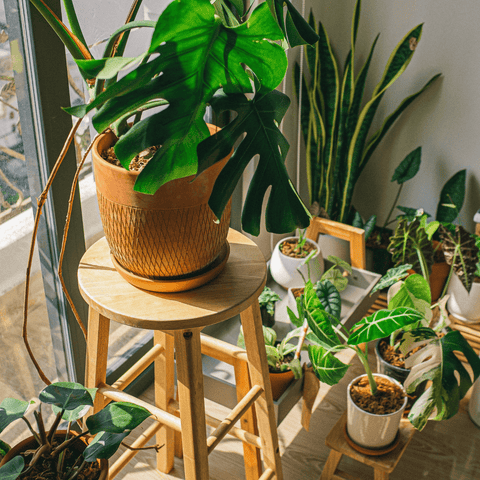This Earth Day, there's a simple way to add some greenery to your home, and it might make you breathe a little easier too! According to a NASA study from the 1980s, a number of common houseplants can absorb carbon dioxide, nitrogen oxides, airborne ammonia and release oxygen as part of the photosynthetic process. But houseplants do more than increase oxygen; they're also natural air purifiers that can remove toxins. While we certainly appreciate fresh air and the fact that being surrounded by greenery and plants is a mood-booster, the air-purifying abilities of plants can also make us feel better physically. By removing these toxins from the air, you can actually reduce symptoms caused by pollutants like headaches, allergies, fatigue, and more. Plants also absorb gasses via the spores on their leaves, reducing airborne mold and leaving us with fresh oxygen!
To reap these fantastic and all-natural benefits, you should include at least one 10-12" houseplant per 100 square feet of space. This will purify the air from pollutants commonly found in detergents, carpeting, furniture, and paints. Once you've decided which ones to go for, you should carefully wipe the leaves with a damp cloth monthly, or more, depending on how dusty your space gets. This will ensure that the plant can absorb carbon dioxide and the plant can release oxygen.
Here are some of our favorites:

The Pothos plant, or "Devil's Ivy," is where interior design meets a low-maintenance indoor jungle. The Pothos family encompasses many colors and varieties: golden, marble, cream, silver, and many more. It can be styled as a vining plant with a support pole to climb up, or it can be hung up to trail down like a lush curtain.
Many beginners find this one of the easiest to grow regardless of its size. The Pothos is flexible with low, medium, and bright light, so it can grow almost anywhere. As an added bonus, the Devil's Ivy is forgiving if you ever miss a watering. As long as it is not in the direct sun rays where the leaves could sunburn and receives ample water, this ivy will thrive!

The Snake Plant, also called "Mother in Law's Tongue," is often the poster child for hardy beginner plants. By looking at its care needs, it's easy to see why. Snake Plants can tolerate any light condition, they can withstand cold weather changes, and they require very little water. This makes a perfect fit for those starting out who are worried that they may forget to water their new plant baby or do not have a sunny growing area.
Like the Pothos, the Snake Plant comes in many different colors and varieties, with dark green, yellow, and silver being the most common. All varieties have the same care needs: flexible on light and temperature, and very low water- a perfect fit for those who have a busy schedule and may be prone to forgetting about watering their plants.
The most common way that Snake Plants are killed is by overwatering. On average, watering this plant just once a month should be sufficient (but like any plant, water needs are proportional to temperature and lighting). When in doubt, do not water until it has been at least a few weeks. While this can survive even the darkest corner, providing the brightest light possible will help your Snake Plant grow faster. Above all, as long as the Sansevieria is not overwatered, it is happy in its new home!

If you're looking for a hands-off plant that makes a statement, the ZZ Plant, a native of East Africa, is the plant for you! This plant thrives on neglect and is a great choice for busy folks, travelers, and those who occasionally forget to water or for an office location. Indirect bright light is best for a ZZ, but they are also content in low light and indirect light, making it a versatile and near foolproof indoor plant. One of the easiest plants out there to care for, it loves nice dry roots and a good drink every 2-3 weeks depending on the time of year and the dryness of the air. While it's not advised to leave it in a window, it can tolerate a few hours of sun during the day while it shoots out bright green fractals of its older foliage.
This plant does well in medium to low indirect light- avoid windows as they amplify the sun's intensity and create heat that may damage plant. Water thoroughly every 2-3 weeks. We recommend adding clay drainage balls to the bottom of the pot; however, avoid overwatering.
4. Parlor Palm / Neanthe Bella

Chamaedorea Elegans, also known as the Neanthe Bella Parlor Palm, is a favorite easy-care palm with tropical fronds known for its air-purifying qualities and ability to grow well over six feet tall. It's native to the rainforests in Southern Mexico and Guatemala. Parlor Palms are a top choice for offices and commercial businesses as they help clean the air and have low light requirements.
The Parlor Palm is non-toxic and is pet friendly. This plant does well in bright to low-direct light and should be watered every one to two weeks, allowing soil to dry out between waterings. Expect to water more often in brighter light and less often in lower light.
5. Peace Lily / Spathiphyllum Wallisi

Simply put, the Peace Lily is a great option for the chronic over-waterer. The foliage is often emerald green with white cone-shaped flowers. The native environment of the Peace Lily is growing under tropical tree canopies, where it is humid, a bit cooler, and low light. To replicate this environment, there is no need to give your Peace Lily too much sun: just place it somewhere it receives a little bit of light. In addition, Peace Lilies can live in room temperature and prefer it on the cooler side. Be sure to keep the soil moist, or as a bonus, place it in a bathroom or near a humidifier to maintain a humid environment for growth.
The most common way of damaging a Peace Lily is by putting it too close to sun, where the sensitive leaves may scorch. So, as long as the Peace Lily is a fair distance from incoming sun rays and the soil is wet but not swampy, the Peace Lily will make itself right at home.





Comments (0)
There are no comments for this article. Be the first one to leave a message!